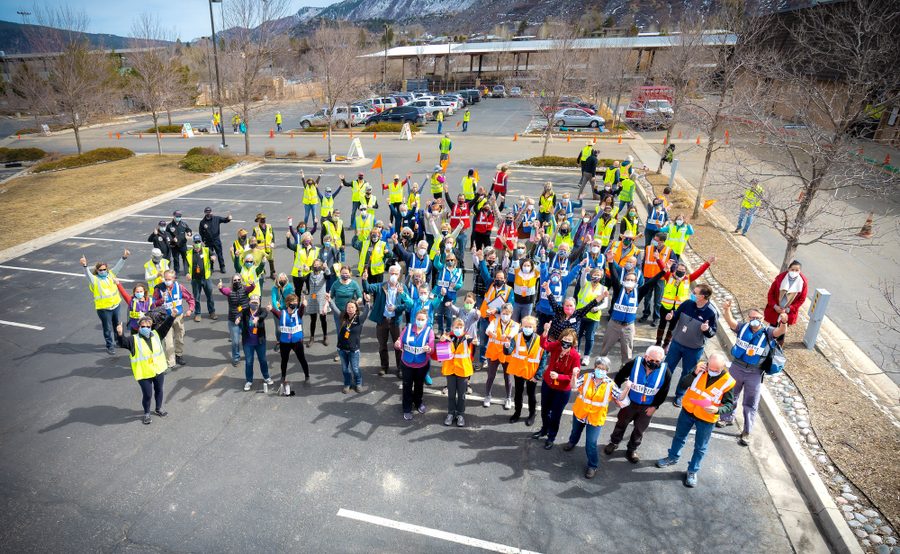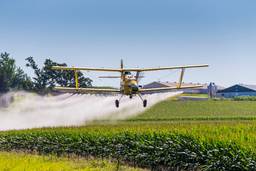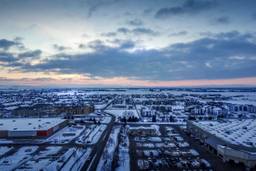How a Rural Colorado Community Self-Organized a Successful Vaccination Effort
Immigrant community groups, forced to organize by the constant threat of ICE, have played a central role as vaccine information networks.
Dave Marston Writers on the Range

Editor’s Note: This column was provided by Writers on the Range, an independent nonprofit dedicated to spurring lively conversation about the West.
Southwestern Colorado is used to spending winters partially isolated from the rest of Colorado, thanks to treacherous mountain passes that hem communities in when bad weather strikes.
That may explain the spirit of can-do volunteerism that drove the county’s early Covid-19 vaccine efforts. Nurse practitioner Karen Zink took on the push for organizing with a Dec. 30 call to San Juan Basin Public Health director Liane Jollon, who gave Zink permission to start planning.
“We were out of the gate in 18 days, with first vaccinations January 18,” says Zink. Their base was the La Plata County Fairgrounds, which Zink credits with being a trusted place, not clinical or political.
Basin Health, which oversees Archuleta and La Plata counties, has since taken over, but Zink’s team pushed the region into the lead statewide, at one point vaccinating 254 people an hour. Now the proof is in the numbers: 70% of seniors over 70 are vaccinated in La Plata County alone.
Why was the county so successful? One answer can be found in the Latinx community. La Plata County is smothered by federal immigration employees, with more working in the Four Corners area than in any other region in the state.
“That consistent threat forced us to organize,” says Enrique Orozco, lead community advocate for Compañeros Immigrant Resource Center, a nonprofit based in Durango. “When the chance for mass vaccination came, we had the beginnings of a network to get the word out if vaccines became available.”
But challenges were everywhere: Few people had access to computers, many had a deep-seated fear of any governmental authority and the population was widely dispersed.
But Orozco had a superb organizer in Beatriz Garcia, program manager at Compañeros who distributes food on Fridays from Compañeros’ office. Orozco says the network she grew to distribute food was perfect for developing a get-the-vaccine chain.
Orozco credits early vaccine recipients for helping to counter Covid vaccination fears. They went out in the community, explaining that the side effects were mild and ensuring that “Latinx vaccine sites (run by Basin Heath) had no police presence and brown Spanish-speaking people were on site for comfort,” says Orozco.
The last 12 months have been painful and sometimes desperate for the people in his community, says Orozco. There were no three rounds of stimulus checks, or extended unemployment help: “If you’re undocumented, and you don’t work, you don’t eat.”
Zink, whose family has ranched the area for several generations and who is founder and co-owner of Southwest Women’s Health Associates, was key to the two counties’ success.
Her fast start was spurred by a Durango Herald article, which ultimately led to 400 volunteers signing up, all of whom had to be certified as health workers via the nationwide Medical Reserve Corps. “I think people were tired of being cooped up,” Zink says.
The big volunteer base meant Zink’s team fielded 15 separate vaccination teams, each with intake personnel, post-shot caregivers and even traffic directors. Combined with other vaccination teams, this gave Executive Director Liane Jollon confidence to tell Gov. Jared Polis that the Durango community could take every shot he could spare when 40,000 doses landed in Denver.
The two small counties, including the indigenous community of the Southern Ute Nation, were ready when 4,000 of those doses — 10% of the state’s total — arrived. The Anglo community helped by calling at-risk residents. A crucial link between Zink and the Latinx community was Anne Markward, who handled technology for the effort with her husband Doug. She had a Zoom meeting with Orozco about getting his list of recipients together. At the time, state guidelines mandated only elderly and folks with impaired health, but once they were vaccinated, the excess went to the Latinx community and other service workers.
With everyone working together, every dose found an arm.
La Plata and Archuleta counties now brag they have one of the highest rates of Covid-19 vaccination in the state, and this is crucial for an economy that depends on tourism for one-third of its economic activity. No one should forget, says vaccine volunteer Jessica Wheeler, that “our economy could not survive without the Latinx community. Whether it’s skilled labor, housekeeping, maintenance or kitchen staff, they support us all.”
Orozco has another group to thank. He credits public health officials for making sure people get protected: “They don’t ask for your age or your job and are doing it on trust.”
Dave Marston is the publisher of Writers on the Range, writersontherange.org, a nonprofit dedicated to spurring lively conversation about the West.





